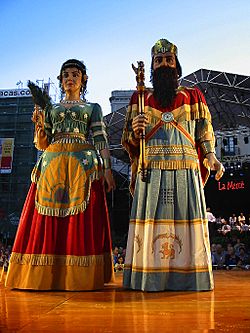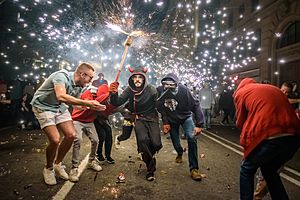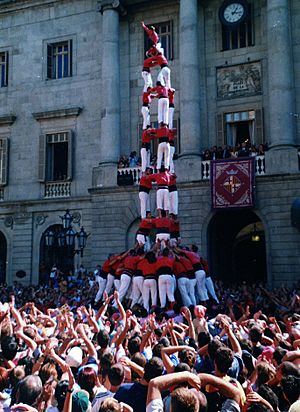La Mercè facts for kids
Quick facts for kids La Mercè |
|
|---|---|

“Gegants” in the feast of La Mercè, 2003
|
|
| Dates | 21-24 September |
| Website | http://lameva.barcelona.cat/merce/en |
La Mercè is a big yearly festival in Barcelona, Catalonia, Spain. It's like a huge birthday party for the city! This festival has been an official holiday since 1871. That's when the local government first planned special events. They wanted to celebrate the feast day of Our Lady of Mercy, called La Mare de Déu de la Mercè in Catalan. Even though the actual feast day is September 24, the fun starts a few days before.
Some of the most exciting parts of the festival began in 1902. Parades then included giant papier-mâché figures called gegants i capgrossos. Also, a popular dance from Empordà, the Sardana, became part of the celebration. Since then, the festival has been super popular with everyone in Barcelona.
Newer traditions include the yearly Catalan Wine Fair. There's also a special correfoc, which is a fiery street parade. Other events are a 10 km race and the pyro-musical. This show combines fireworks, water fountains, and music. It all happens at the base of Montjuïc mountain.
Contents
History of La Mercè Festival
The La Mercè festival started with religious roots. It honors the Virgin of Grace (Mare de Déu de la Mercè). She is a special protector of Barcelona. In Catalan, the word mercè means service, help, or kindness. In the Gothic Quarter of Barcelona, there's a church dedicated to her. Inside, you can see a wooden statue of the Virgin.
People have celebrated this festival since the Middle Ages. In 1687, Barcelona faced a big problem: a plague of locusts. The city's leaders asked the Virgin for help to get rid of the insects. When the city was saved, she was named the patroness of Barcelona. The Pope officially recognized this in 1868. Since then, Barcelona has held an annual festival to honor the Virgin.
What to Do at La Mercè
During the week-long festival, almost two million people come to enjoy the fun. There are cultural and artistic shows all over the city. The most traditional activities show off the popular culture of Catalonia. The street parades are a highlight. They come from the amazing processions that happened centuries ago. Each day of the festival has its own parade. These parades are full of mythical characters and traditional drumming.
There are about 600 events happening in squares, streets, museums, and parks. The best part is that all the entertainment is free! Barcelona's metro trains run all night during the festival. Street theater is a big part of the artistic events. You can see dance, circus acts, bands, and touring shows. To help people learn about other cultures, each year a "Guest City" is invited. This city shares its culture and artists. In 2013, the Guest City was Vienna.
Building Human Towers: Castellers
Castellers are human towers, and they are a very important part of La Mercè. Castells, which means "castles" in Catalan, are a special tradition in Catalonia. People work together to build these amazing human towers. This tradition started in the late 1700s in Valls, Province of Tarragona. Rival groups of people called colles began to compete. They wanted to see who could build the best and tallest human towers.
See also
 In Spanish: Fiestas de la Merced para niños
In Spanish: Fiestas de la Merced para niños



